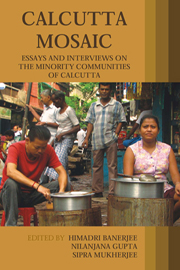Book contents
- Frontmatter
- Contents
- List of Contributors
- Acknowledgements
- Introduction
- 1 Mapping the Spaces of Minorities
- 2 The Armenians of Calcutta
- 3 The Jews of Calcutta: An Interview with Michael Ezra
- 4 The Sindhis of Calcutta
- 5 The City of Colleges
- 6 The Chinese Community of Calcutta
- 7 The Anglo–Indians of Calcutta
- 8 The Biharis of Calcutta
- 9 Agraharis of Calcutta
- 10 A Journey into My Neighbourhood
- 11 The ‘South Indians’ of Calcutta: Experiences in Cultural Processes
- 12 ‘Non-Bengali’ Icons of Malevolence
- 13 Selfing the City
8 - The Biharis of Calcutta
An Interview with Sachchidand and Indu Rai
Published online by Cambridge University Press: 05 March 2012
- Frontmatter
- Contents
- List of Contributors
- Acknowledgements
- Introduction
- 1 Mapping the Spaces of Minorities
- 2 The Armenians of Calcutta
- 3 The Jews of Calcutta: An Interview with Michael Ezra
- 4 The Sindhis of Calcutta
- 5 The City of Colleges
- 6 The Chinese Community of Calcutta
- 7 The Anglo–Indians of Calcutta
- 8 The Biharis of Calcutta
- 9 Agraharis of Calcutta
- 10 A Journey into My Neighbourhood
- 11 The ‘South Indians’ of Calcutta: Experiences in Cultural Processes
- 12 ‘Non-Bengali’ Icons of Malevolence
- 13 Selfing the City
Summary
The Biharis have been part of Calcutta since the last few centuries. The three states of Bihar, Orissa and Bengal comprised what was in the nineteenth century rather officiously called ‘Greater Bengal’. With both the geographical proximity and the absence of any geological barriers encouraging movement of people among these states, migration to the city of Calcutta has been a regular phenomenon. Interestingly, though the term ‘Bihari’ predates the recent division of the larger state of Bihar, the term was generally not used to refer to people from areas which today are included in the Jharkhand state. The cities and towns of the modern state of Jharkhand – Hazaribagh, Jamshedpur, Maithan, Ranchi, are viewed by most Calcuttans as being familiar enough to be mistaken for towns of Bengal. It has been the people from the districts of Monghyr, Katihar, Purnea, Bhagalpur, Saran (with its subdivision of Chhapra) who have always been identified as the ‘real’ Biharis.
Though the image of the Bihari migrant is often of one who is among the poorest, this may not always reflect reality. Much of the rural–urban migration, as other researches in South Asia and Africa has also shown, is of a circular character. Almost all the Bihari migrants continue to maintain links with their areas of origin in rural Bihar. In the southern African context, or colonial India, this has been attributed to policies that restrict the settlement of migrants with their families.
- Type
- Chapter
- Information
- Calcutta MosaicEssays and Interviews on the Minority Communities of Calcutta, pp. 153 - 163Publisher: Anthem PressPrint publication year: 2009



